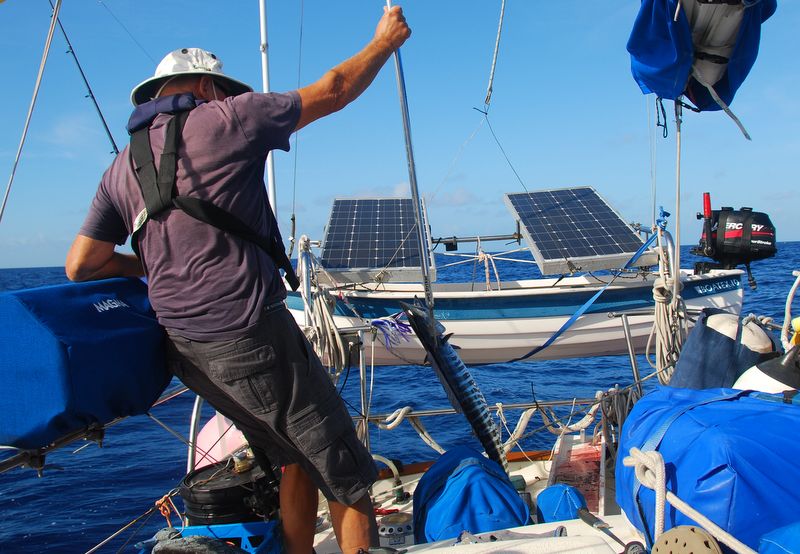
Yahoo … a Wahoo for our empty freezer
The Bahamas. March, 2015. Eluthera: A Bahamian Garden
We spent most of January, February and early March in the Exuma island chain. Most of February and the first two weeks of March we had consistent, strong wind, mainly from the east, which kept us from moving further east and south of the Bahamas towards Grenada. The second week of March we gave up our plan to summer in Granada and decided to leave the boat in Florida for hurricane season. On March 16 we crossed Exuma Sound (20 miles) with light winds. It was mainly a motor trip with a little boost from the sails. Brian had two lines out and was successful in landing a Mahi Mahi and a Wahoo. We smoked a bit of each and stored several meals of fish in the freezer. Just as we approached Eluthera Bank, a heavy downpour cleaned the salt from the boat. We did a couple of donuts waiting for the visibility to improve before getting on the banks for the final 10 miles to Rock Sound.

Yahoo
… a Wahoo for our empty freezer
In general Eluthera seems more prosperous than the Exumas. There is better soil and more water on this island, which means some limited agriculture flourishes. There was a cattle farm at Hatchet Bay and pineapple plantations in the 19th century, but such large agricultural enterprises are no longer in existence. We saw a strange cactus-like plant at Alabaster Bay that may have been a wild pineapple. We saw mango, banana and plantain trees, which we never saw in the Exumas. Houses were surrounded by gardens with colourful flowers, especially bougainvillea. Some of the houses had small vegetable gardens.
Rock Sound. We spent 5 days anchored in Rock Sound. Ashore we found the much needed Laundromat and grocery store. We were out of beer, wine and coffee. Our only fruit was a few lemons and limes, and the vegetables were turning brown and sparse. The only meat was 4 hot dogs (and the fish, of course). The islands depend on the mail/supply boat for fresh fruit and vegetables and frozen meat. In the Exumas, outside of George Town, the grocery stores are about the size of a convenience store. When the boat arrives (and there is not dependable schedule) the fresh food is snapped up in 24 hours. The Rock Sound grocery store is bigger and better stocked than most of the stores in the Exumas and we stocked up for anticipated 6 weeks until we arrived back in Florida.
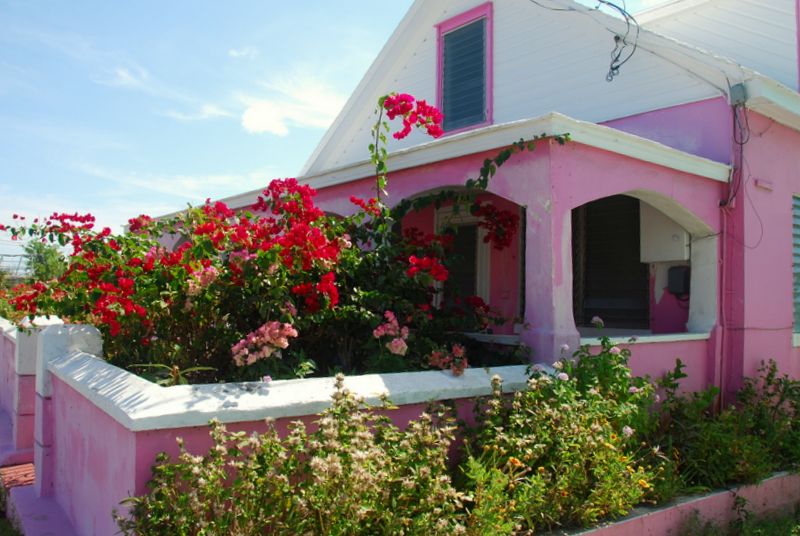
Bougainvillea
and a colour co-ordinated house
Governor’s Harbour. For 6 weeks we had strong wind almost every day. For the last two weeks of March we had no wind. We left Rock Sound and motored 20 miles north to Governor's Harbour. It was Bahamas' first seat of government and there is still some evidence of the colonial architecture. With no wind and blazing sun, it is easy to get heat exhaustion, especially if we cannot get into a shaded area. We were glad there was little wind since the sea bottom of the anchorage area is strewn with debris that keep anchors from getting a good bite. We walked around this quaint town ... not very prosperous, but quite friendly. It has the best quay we have seen in the Bahamas for small container ships and one came in while we were anchored.
We had lunch at the most popular take-out place and after several tastings have decided cracked conch is not all that it is cracked up to be. It is battered and deep fried and frankly tastes like most other fish and meat that is battered and deep fried. It was Friday night, and every Friday night there is a fish fry with live entertainment. We were serenaded to sleep.
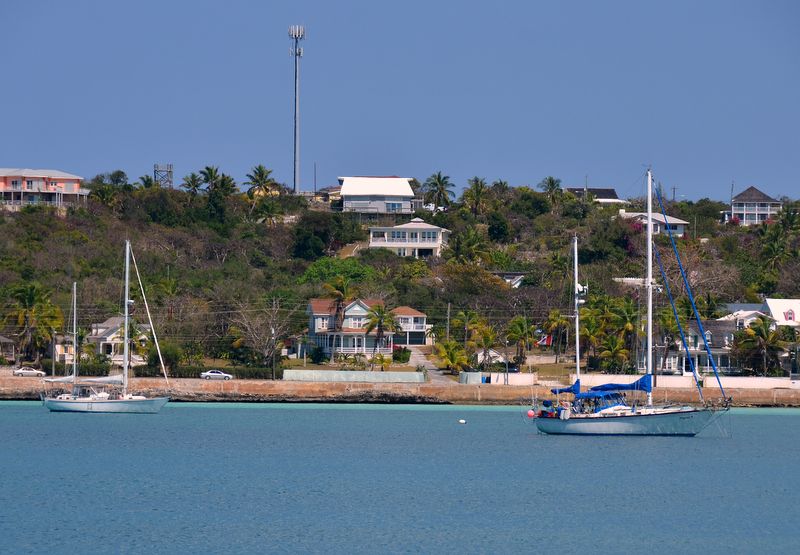
Hold Fast and Pilgrim
Alabaster Bay. The land visit at Alabaster Bay was exhausting due to the heat and getting lost on an abandoned US military base. We were anchored and landed the dinghy on the west shore of Eluthera and hiked across the narrow island (no more than 1 mile wide at this point)to the eastern shore with waves breaking over its barrier reefs. The beaches along the eastern shore are "pink." There are pink specks in the sand, and the beach is lovely, especially with the turquoise waters and breakers, but the beach is not hot pink. Only a few people in the nearby resorts were walking on the beach; we had it pretty much to ourselves. There were no shells, crabs or birds.
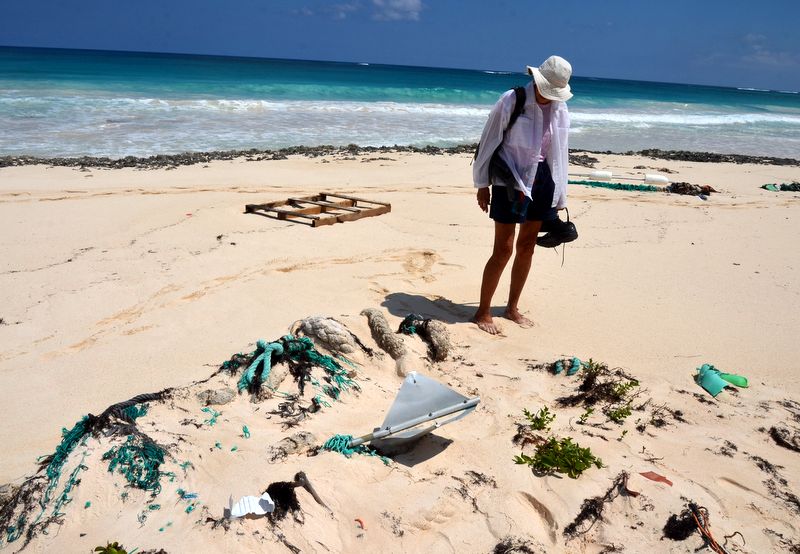
Storm damaged fishing net complete with a radar reflector
We followed a trail from the beach to the remains of a US military base built in the 1940's to detect German submarines. It was transformed into a missile-tracking site in the 1960's during the Cold War and the Cuban Missile Crisis, and abandoned sometime after 1973, the date on a fire hydrant. A huge area had been excavated and then paved to create a sloping surface to collect rain water and pump it into reservoir tanks at the top of the base. Some buildings could be identified: barracks, mess, wash house, officer's club. A vehicle repair garage was still standing with the remnants of old trucks and a John Deere tractor / grader. It is astounding that the Bahamian government did not maintain or do anything with the property when the US left. There were plenty of goodies that were just left to rust.
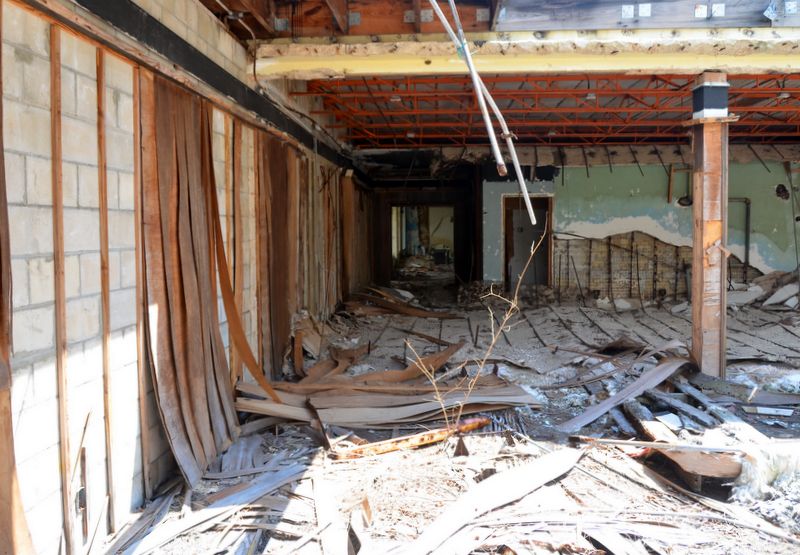
Officers Mess ?
Hatchet Bay has its own interesting history. An Englishman thought that the land was good for raising cattle. He brought in stock and grew silage. He built silos and barns. In order to import grain to finish off the cattle, he blasted a 90-foot wide channel in the limestone cliff that separated a natural small lake from the sea so that barges could deliver grain. He was so successful that the Bahamian government taxed him to death; he slaughtered all the stock and went back to England, leaving the channel intact for us cruisers/tourists. It is one of the most secure anchorages in the Bahamas, despite the amount of debris, wrecks, etc. left on the bottom. Alice Town is the settlement here, and the main industries are power generation (diesel), water purification and tourism. A high-speed catamaran car ferry runs from Nassau to Alice Town every Friday evening and Sunday evening for the commuter traffic. (Eluthera residents who work in Nassau)
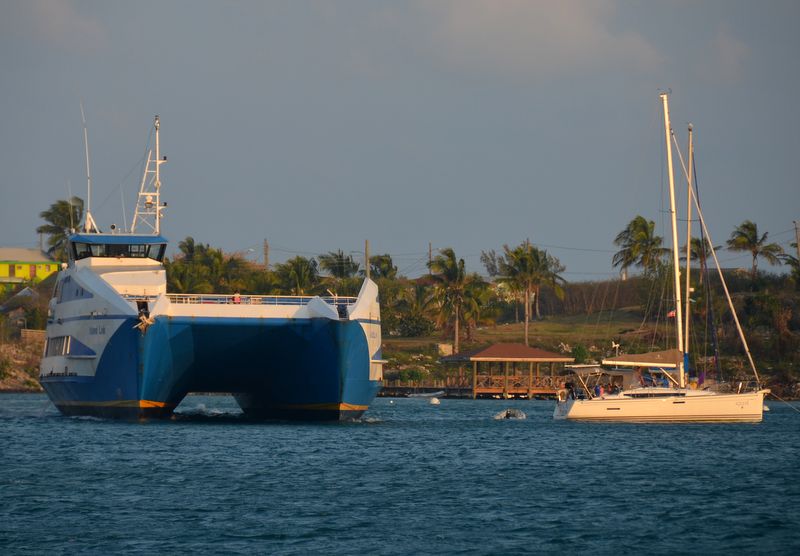
The high-speed catamaran car ferry that runs from Nassau to Alice Town
Our stay in Hatchet Bay was longer than anticipated. We experienced two major squalls during the week we were there. The first squall hit us around 4PM; the wind suddenly freshened to 25 knots from the north. We quickly closed the hatches and ports and started monitoring our position since two boat had anchored a little closer that comfortable on either side of us. Our anchor either held or reset quickly. However there were two catamarans under 30 feet that were rafted together on one anchor. When the squall hit, they separated, but before they could take control of their boats were blown dangerously toward the jagged limestone shoreline. Dinghies with 15 HP engines quickly helped tow them off the rocks, but then abandoned them when their concern shifted to the safety of their own anchored boats. As soon as the wind quieted to 15 knots, Brian lowered our dinghy (with 5 HP motor) and we helped get one of the boats tied to a mooring and the helped the other extract an anchor that was keeping the boat too close to the shore. The squall was over in 15 minutes, but that short space of time could have caused much damage to several boats.
The second squall arrived in the middle of the night. At 1AM we woke to rain. Before we could close the cockpit enclosure and portholes the wind veered from south at 15 knots to northwest at 25 knots and we had brilliant flashes of lightning. Torrential rain followed. The power in the settlement failed and we saw the emergency vehicles rushing to the power generation plant to restore power. Finally at 3:30 the major part of the storm subsided enough for us to climb back into bed. The cold front followed the squalls, but the wind in the front was only moderate from the north and brought cooler temperatures.
Alice Town is the settlement on Hatchet Bay. It has character and charm. The mail/ supply boat was a surprisingly old vintage, nothing like the boats that supply the Exumas with cranes to unload skids and the container ship in Governor’s Harbour.
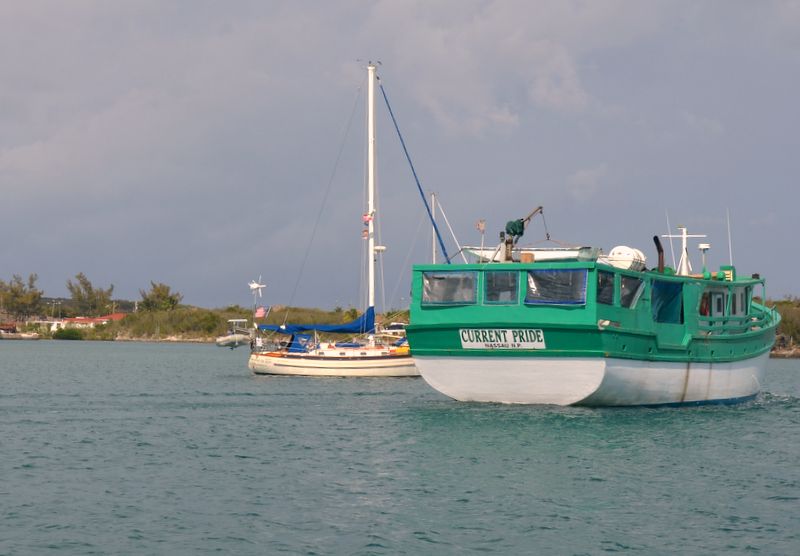
The weekly Mail Boat
The Glass Window. 10 miles to the NE of Hatchet Bay is the tip of Eluthera where there is a short, low isthmus that joins the long south part of the island with the east/west north part of the island. A barrier reef keeps the Atlantic swell from crashing on much of the eastern shore of Eluthera, but right at the Glass Window the waves converge on this tiny isthmus and boil over the low land. In the 19th century there was a natural arch over the isthmus that was demolished during a hurricane. A bridge was constructed to replace the arch. It is about 170 feet long, and it has suffered hurricane damage as well. There are a couple of huge rocks, the Bull and the Cow that sit on the high land, tossed from the sea during a storm. The water surging under the bridge looked more like whipped cream than water, it was churning that much. There were also blow holes. During our visit the wind was less than 10 knots. In stronger wind walls of water are whipped up on the Atlantic side and there are warnings to keep children close at hand.
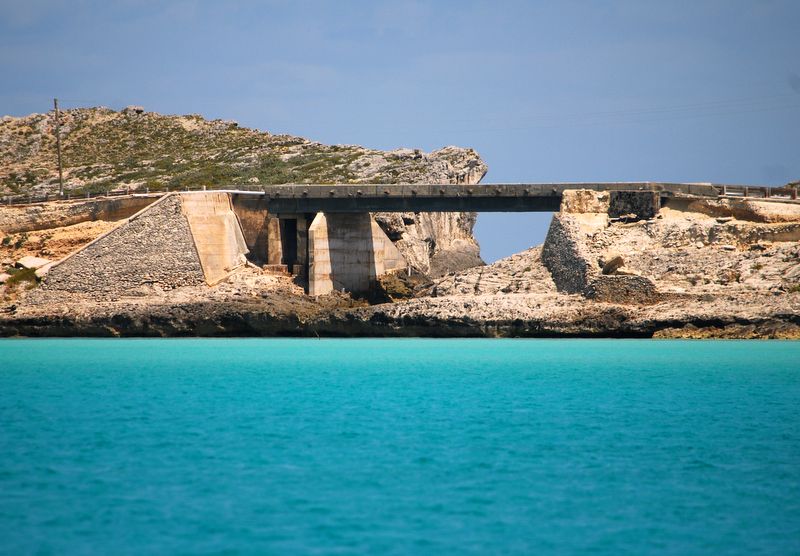
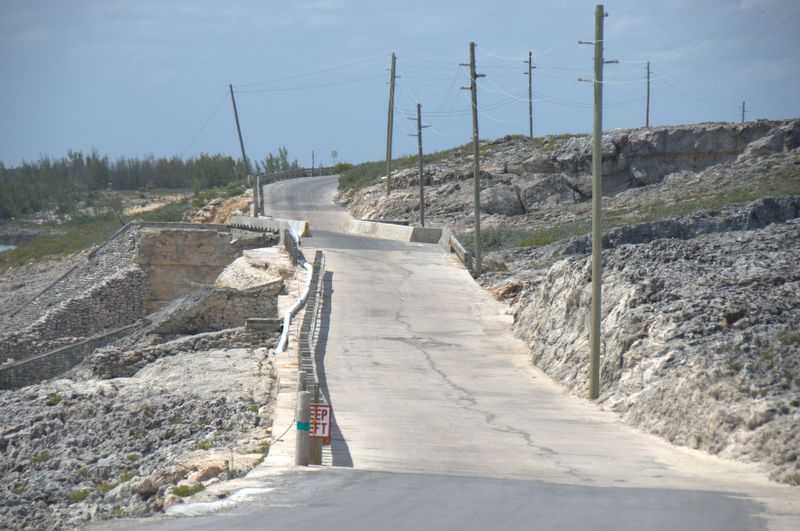
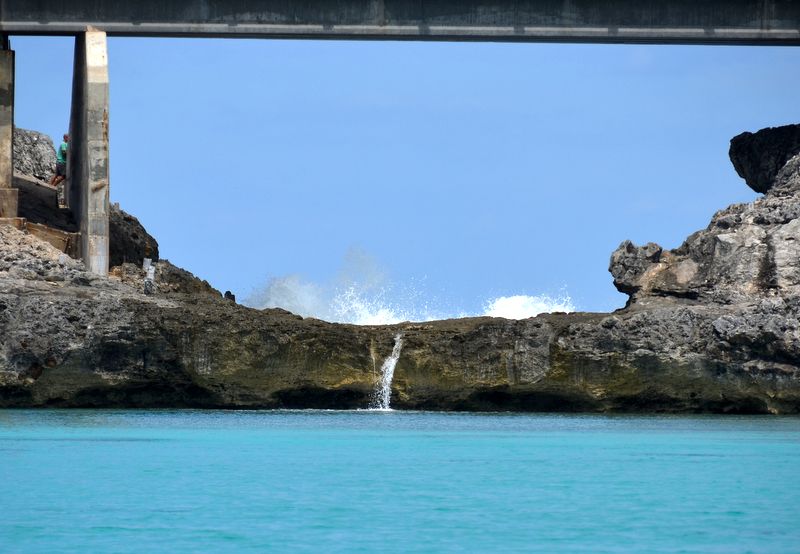
The Glass Window Bridge Calm on the inside … rough on the outside
Spanish Wells is due north of the Glass Window, but to get to it we had to go 10 miles to the west and through The Current, a cut between islands where the current can run up to 4 knots, and then backtrack east to the settlement. The mooring we picked up was less than a boat length from a mangrove swamp, so the no seeums were dense.
Spanish Wells was a bit of a disappointment. It is a commercial fishing port, but the town is almost entirely white Bahamians and tourists. Dark-skinned Bahamians who work here take the ferry back to North Eluthera in the evening; they do not live here. One large (on Bahamian standards) grocery store looks like it would be more at home in southern Florida. No one walks; golf carts and cars are the only means of transportation other than the ferry.
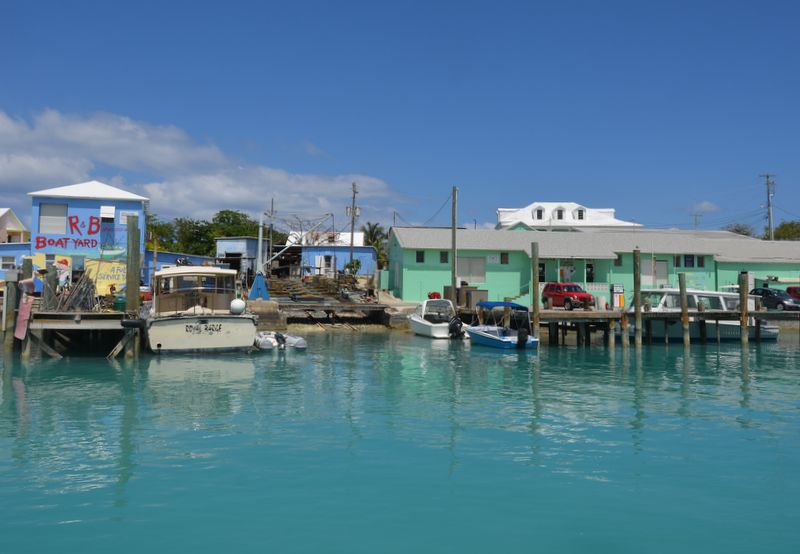
Spanish Wells dockside
While we Spanish Wells we took a side trip to Harbour Island. The trip required us to take two ferries with an van trip from one ferry dock to the other. Barbour Island lies off the NE tip of Eluthera and forms a shallow, protected harbour. It reminded us of Palm Beach. Most of the residents were from the US in their winter holiday homes. Homes overlooking the Atlantic beach are priced at $4 million. Everyone travels via golf cart. There are no sidewalks since no one walks anywhere. Beautiful homes, gardens, shops. Expensive. We are glad we did the trip, but have no desire to return.
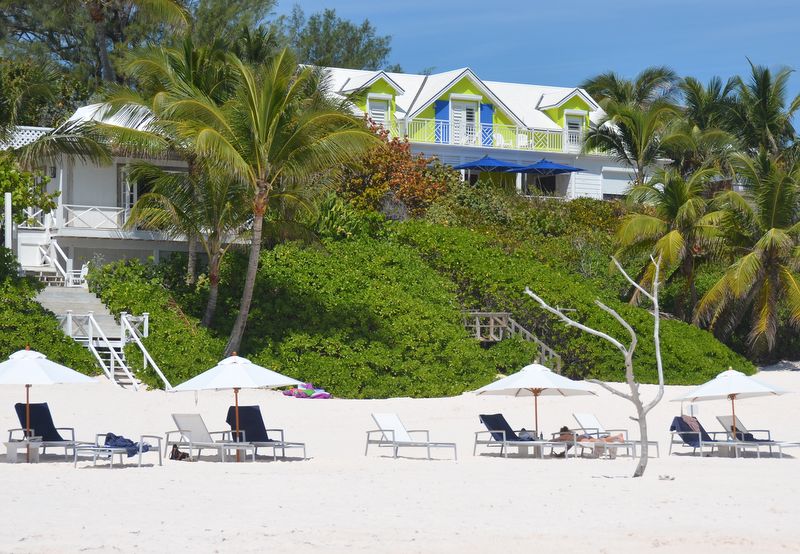
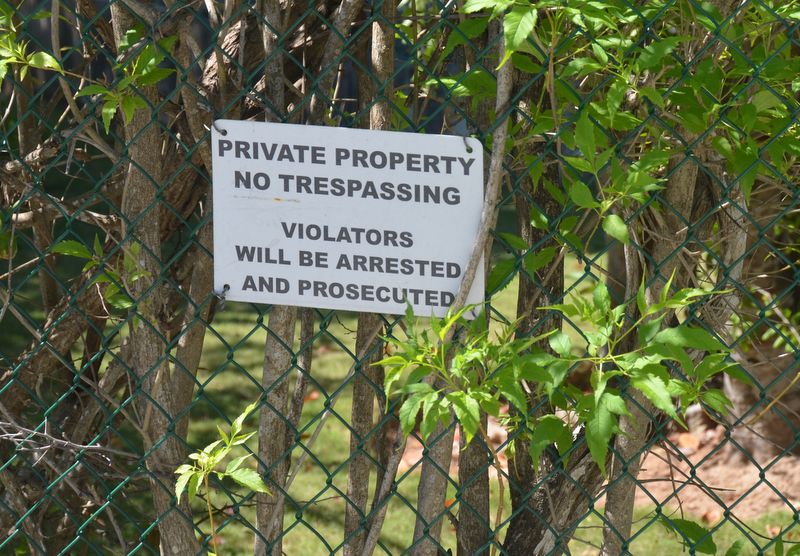
Harbour Island for the rich and famous
Royal Island. We decided to wait for a weather window to make the trip back across the Gulf Stream to Florida in this well-protected harbour. We enjoyed watching the sea turtles swimming around the boat. Brian had a scrap of fish yesterday when we was preparing some Mahi for smoking. He put the scrap on a hook and put it in the water. About an hour later, there was movement on the line. We saw the turtle head. S/he had stripped the fish off the hook and was thanking us for the treat. There are also a variety of rays here. In Spanish Wells, as we went out the west channel, which is fairly narrow (60 feet wide) Brian was on the bow looking for rocks. A catamaran had gone hard aground just off the channel the day we arrived and we wanted to make sure to avoid the rocks. There was no wind, no water ripples. Brian could clearly see the bottom of the channel and the very steep coral sides to the channel (at less than 30 degrees incline). This is where the catamaran grounded. We were far enough off the "cliff" but large rays were swimming up and down the steep incline much like a flock of birds, or synchronized swimmers, picking little morsels off the cliff.
Gulf Stream Crossing / Cape Canaveral. Our 290 mile passage took 49 hours, 18 of which we were sailing. The wind was much lighter than expected for the first 24 hours so most of the day we motored. Brian had a fishing line out, and just before 6 PM something took the lure, but cleanly broke the line and got off. Another line was put out and almost immediately Brian had another strike. It took 20 minutes to bring the feisty fish close enough to the boat to gaff and bring aboard. A beautiful Mahi Mahi, larger than the one Brian caught in Exuma Sound. It was a welcome farewell from the warm turquoise waters of the Bahamas. Mahi does very well in the smoker, so Brian smoked half of the catch.
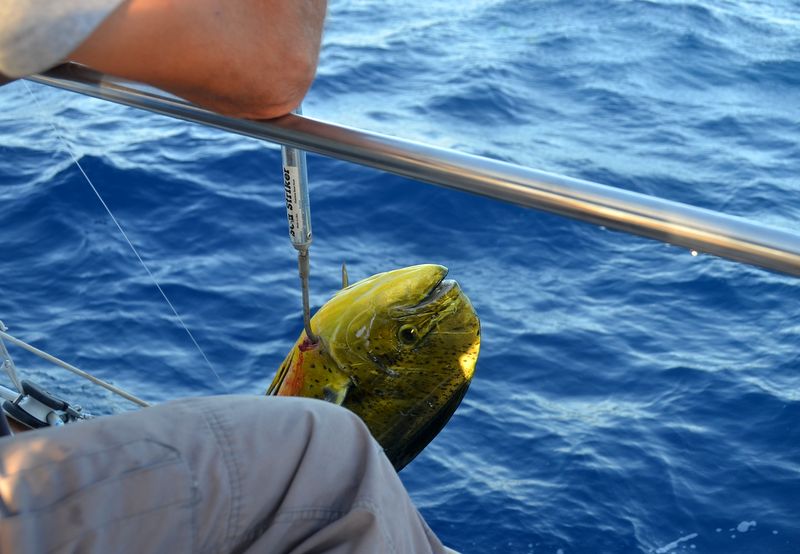
Mahi for the smoker
We were amazed at the number of cargo ships were "drifting" in the deep waters near Freeport Sunday night waiting for a pilot and dockage. All had AIS transponders, so we could "see" these boats on our electronic chart, but it was impossible to predict when one might start moving or change direction.
Once we were in the Gulf Stream the NE 5-foot swell became a strong force, stronger than the 15-18 knots of easterly wind. Pilgrim felt like the inside of a washing machine, and the noise of the rigging, the mast and the sail along with the sometimes violent motion of the boat meant neither of us really slept during the passage. At the entrance channel to Port Canaveral we were greeted by a very large sea turtle.
When we were hauled out we had the bottom paint sand blasted off. Because of repairs to the rudder and hull since we applied Interlux 2000 as a barrier coat in 2003, the bottom paint has been flaking off making an uneven surface. We left the masts stepped, the cockpit enclosure in place and draped a sunscreen fabric over the main boom. We hope Pilgrim has a good hurricane season in Cape Canaveral. We will be back to launch her in November.
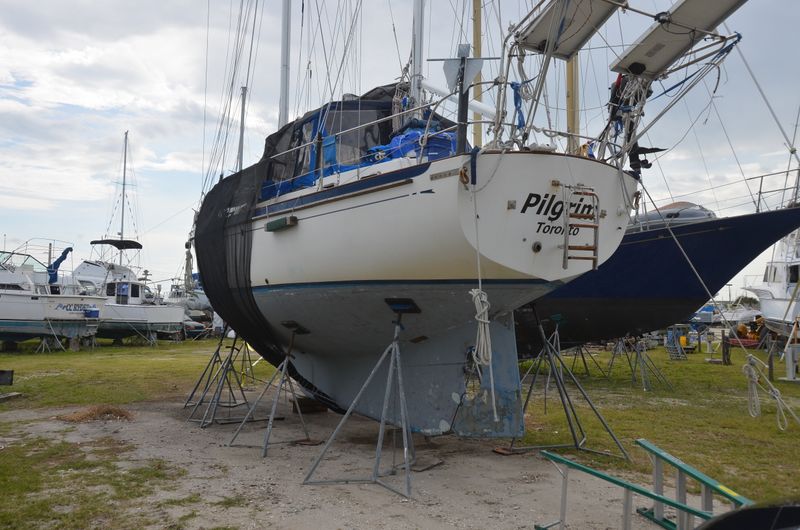
Question. Cruisers sometimes volunteer to teach in the school where they are anchored. We wonder if volunteers, especially those who are not trained as teachers, are doing real good by parachuting in for a few days or weeks to teach when they do not know the curriculum, teaching expectations,culture, etc. Do the teachers appreciate the help, or does it suggest that they are not fully qualified to teach some subjects? How do we ascertain what the Bahamian settlements need? Are we making ourselves feel good by volunteering, or really benefiting Bahamians? We do not know the answer... we are just asking the question, but do not really know who to ask.